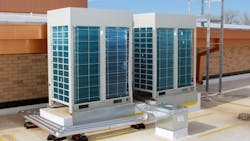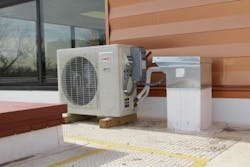Case Studies in Commercial Ductless Systems: Lennox VRF Brings Multiple Benefits to School Addition
In early 2016, Abilene High School went through major renovations, including a large addition to its existing building. The expansion was needed due to a growing student population, and it presented a huge opportunity and significant challenge when the time came to install a new heating, ventilation and air conditioning system.
Project Challenge
The design engineer from PKMR Engineers had a strong relationship with Lennox, but was relatively unfamiliar with the newer Lennox VRF and mini-split product lines. For this reason, a Lennox competitor was being considered for the project, but the Lennox VRF team successfully leveraged the strong relationship and educated the engineer on the Lennox VRF and mini-split products, and ultimately instilled the confidence needed to award the project to Lennox.
Another challenge faced in the design was how to best condition the very different types of spaces within the addition: various small offices with one or two occupants as well as larger classrooms with more occupants and very large gymnasiums.
Another challenge faced in the design was how to best condition the very different types of spaces within the addition: various small offices with one or two occupants as well as larger classrooms with more occupants and very large gymnasiums.
There were layout challenges to address as well, since the more similar spaces — offices and classrooms — were separated by the two gyms located in the middle.
The Solution
Several Lennox products were selected as a combined system that could deliver elegant solutions in response to the various and challenging needs of the project. The designer implemented Lennox Energence® rooftop units to replace the RTUs already in place at the high school, as well as to condition the two new gymnasiums and other spaces for the building addition.
Lennox VRF heat recovery units, combined with Lennox mini-split heat pumps, were selected for the new offices, classrooms and equipment rooms on either side of the gyms. Central control system were implemented via the Lennox L Connection Network or RTUs and the Lennox VRF Manager (LVM) for VRF and mini-splits.
To complement the LVM, programmable local controllers for the VRF indoor units and wireless controllers for the mini-split indoor units were used to put the power of control in the hands of the occupants in each zone. Owner training was provided by Lennox.
The Result
Lennox was the basis for the design on all the equipment for this project, which resulted in a successful combined application installation, start-up and owner training. All goals that were outlined in the beginning of the project were achieved via a combination of Lennox Energence® rooftop units, VRF, commercial split and mini-split systems.
The VRF and mini-split systems provided the installation flexibility, energy efficient operation, low sound levels and zone temperature control needed in the classrooms, office spaces, and equipment rooms for this school building addition, all accompanied by support and extensive expertise from Lennox.
Multiple Benefits
The new HVAC system now provides and maintains a constant and comfortable environment for the students, teachers and administrators. The Lennox solution met the layout challenge of the added square footage needing an HVAC system that was simple and flexible, and that provided individual zone control and energy savings.
The VRF and mini-split systems also provided the modern look and feel that the district set out to achieve.
Lennox Makes its Way in Crowded VRF Market
Lennox Commercial entered the VRF market in the fall of 2014. Now, as it works through its third year as a major VRF manufacturer, product teams are “finding their way, and encountering much success,” according to Chris Drury, vice president of sales for the division.
“It’s been a fun two years in this role of leading the sales efforts. Every day there’s more good news,” he said, and added that the Lennox reputation has helped open doors to commercial VRF projects.
“Lennox has been a trusted name in HVAC for 122 years, with a great customer base. [Contractors and end users] know the quality and support they will get from Lennox,” he said.
Drury acknowledged that the advantages of commercial VRF systems are attractive to engineers and builders in health care, lodging, school, multi-family and office settings. “Lennox has been known as a unitary HVAC provider of rooftop units and split systems. Medium- to large-size office buildings or high-rise multi-family settings, were vertical markets that were tougher to break into with unitary HVAC equipment up to 50 tons. VRF has allowed us to get into those vertical markets, and allowed us to compete and win. Office buildings and multi-family locations are now two of our biggest VRF vertical markets, and the ones in which we’ve had the most success,” Drury said.
Drury pointed to K-12 educational settings as especially active sectors for Lennox. “Many K-12 schools in the Midwest and South-Central areas of the U.S. use rooftop units, and they’re incorporating VRF,” he said. “You may be using rooftop units for gymnasiums and auditoriums, and they are a great fit. But when you match those up with VRF for the classroom areas, and they’re all from one supplier, it’s a win-win for the school, the engineer, and the mechanical contractor.”
Drury said Lennox Commercial has placed its VRF line with equal success into both new construction jobs and retrofit projects.
“We’re out in front with engineers on the design side for new buildings, and we’ve seen a lot of our products in existing structures, where they’re replacing older rooftop units or chillers with VRF systems, particularly for the zoning needs. It’s much less intrusive when you’re going in through a structure with 3/8-in. or 5/8-in. pipe rather than running large ductwork or large water pipes through the structure,” he explained.
Who is kickstarting the VRF discussion? Engineers? Builders?
“It’s being driven through consulting engineering firms and Design/Build contractors,” he answered. “Engineers know that the technology is highly efficient, with individual zone controls. Building owners are always looking for the most energy efficient solution, but they’re not schooled in the different HVAC technologies. They want the building to be comfortable, with no ‘thermostat wars’ caused by hot spots and cold spots. Once the owner has experience with VRF and the benefits that come with it — lower energy bills and reduced comfort complaints — they want to go back to it,” Drury said.
— Terry McIver

